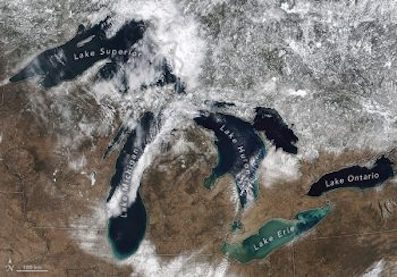 Cleanzine: your weekly cleaning and hygiene industry newsletter 10th July 2025 Issue no. 1170
Cleanzine: your weekly cleaning and hygiene industry newsletter 10th July 2025 Issue no. 1170
Your industry news - first
The original and best - for over 20 years!
We strongly recommend viewing Cleanzine full size in your web browser. Click our masthead above to visit our website version.
'Forever chemicals' found to rain down on all five North American Great Lakes
 Perfluoroalkyl and polyfluoroalkyl substances, also known as PFAS or ‘forever chemicals’, have become persistent pollutants in the air, water and soil.
Perfluoroalkyl and polyfluoroalkyl substances, also known as PFAS or ‘forever chemicals’, have become persistent pollutants in the air, water and soil.
Because they are so stable, they can be transported throughout the water cycle, making their way into drinking water sources and precipitation.
According to findings published in ACS' Environmental Science & Technology, precipitation introduces similar amounts of PFAS into each of North America’s Great Lakes; however, the lakes eliminate the chemicals at different rates.
Consuming PFAS has been linked to negative health outcomes and last month, the US Environmental Protection Agency designated two forever chemicals - PFOS and PFOA - as hazardous substances, placing limits on their concentrations in drinking water. The Great Lakes are a major freshwater source for both the US and Canada, and the EPA reports that the surrounding basin area is home to roughly 10% and 30% of each country's population, respectively.
Previous studies demonstrated that these lakes contain PFAS, but Marta Venier at Indiana University and colleagues from the US and Canada wanted to understand where the compounds come from and where they go.
Between 2021 and 2022, 207 precipitation samples and 60 air samples were taken from five sites surrounding the Great Lakes in the US: Chicago; Cleveland; Sturgeon Point, N.Y.; Eagle Harbor, Mich., and Sleeping Bear Dunes, Mich. During the same period, 87 different water samples were collected from the five Great Lakes. The team analysed all the samples for 41 types of PFAS and found that:
• In precipitation samples, PFAS concentrations largely remained the same across sites, suggesting that the compounds are present at similar levels regardless of population density.
• In air samples, Cleveland had the highest median concentration of PFAS and Sleeping Bear Dunes the lowest, suggesting a strong connection between population density and airborne PFAS.
• In the lake water samples, the highest concentration of PFAS were in Lake Ontario, followed by Lake Michigan, Lake Erie, Lake Huron and Lake Superior.
• The concentration of PFOS and PFOA in lake water decreased compared to data from previous studies as far back as 2005, but the concentration of a replacement PFAS known as PFBA remained high, suggesting that further regulation efforts may be needed.
The team calculated that airborne deposition from precipitation is primarily how PFAS get into the lakes, while they're removed by sedimentation, attaching to particles as they settle to the lakebed or flowing out through connecting channels. Overall, their calculations showed that the northernmost lakes (Superior, Michigan and Huron) are generally accumulating PFAS. Further south, Lake Ontario is generally eliminating the compounds and levels in Lake Erie remain at a steady state. The researchers say that this work could help inform future actions and policies aimed at mitigating PFAS' presence in the Great Lakes.
The authors acknowledge funding from the Great Lakes Restoration Initiative from the US Environmental Protection Agency's Great Lakes National Program Office.
23rd May 2024







